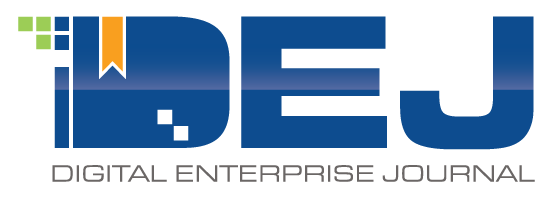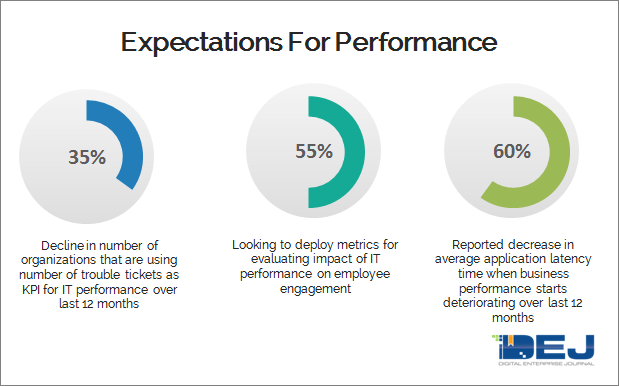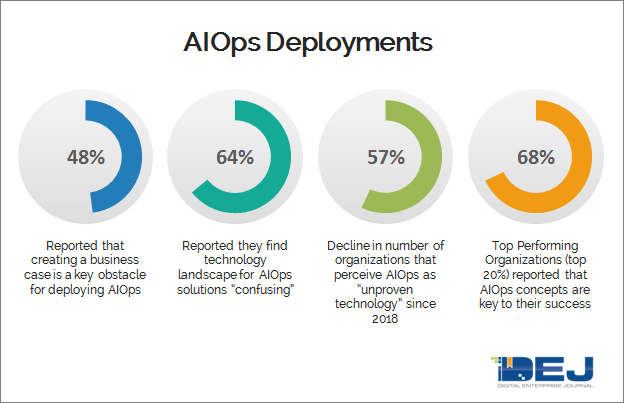In the second half of 2019, DEJ surveyed more than 3,000 organizations around a variety of topics about managing IT performance. Our analysis identified 18 key areas that will have the strongest impact on IT performance markets in 2020.
1 – Managing dynamic environments
The emergence of different types of cloud services (hybrid, native, multi, etc.), microservices and containers and an increased adoption of practices, such as CI/CD and DevOps is changing the game when it comes to ensuring optimal IT performance. DEJ’s research shows that organizations are increasingly realizing that managing these dynamic environments by using tools and practices that were deployed in the past is not an effective strategy.
When managing these types of environments, organizations are running into a broad set of challenges that are unlike any use cases they have dealt with before. Technologies and practices that are creating these dynamic environments are in the core of digital transformation and using technology as a competitive advantage (TaCA), but ensuring their optimal performance requires a new approach and capabilities.
54% of organizations reported that they are evaluating IT solutions based on their impact on business outcomes
2 – Focus on business outcomes
With the increasing goal to use technology as a source of competitive advantage, organizations are changing their processes for evaluating new solutions. DEJ’s research shows that business professionals and executives are increasingly becoming a part of a technology procurement process. However, the research also shows that these individuals don’t want to go back to school to understand the value of different technologies, as 58% of them reported their interest in learning more about technology features and functionalities as “low” or “very low”.
DEJ’s research shows that the value proposition of IT performance solutions is very well aligned with the goals of business and digital transformation leaders, but it is often very difficult for non-IT professionals to see that alignment. In order to drive future growth of their target markets, IT performance management vendors need to modify their messaging and help organizations connect the dots between technology value and desired business outcomes.
3 – New expectations for performance
DEJ’s 2019 research study “The Roadmap to Becoming a Top Performing Organization in Managing IT Operations” shows that higher expectations for customer (both external and internal) experience is the #1 driver for modernizing IT operations. As a result, the norm for what optimal IT performance means to organizations is increasing and organizations are not only setting higher goals and benchmarks for KPIs that they have been using, but also introducing new metrics for evaluating performance.
In order to address this trend, organizations need to develop a new approach for evaluating their IT performance that should be built around two key areas: 1) focus on user experience and business results; and 2) preventing performance issues before users are impacted.
4 – Keeping up with the amount of change
DEJ’s research shows that the amount of change in IT environments has been increasing by an average annual rate of 86% since 2016, with the pace of change accelerating each year. The research also shows that 76% of IT performance issues are caused by change. Frequency of events such as deployments of new technologies, software releases and/or updates and changes in workflows went from several occurrences per year to something that is happening on a daily basis and organizations are put in the position to constantly play catch up when managing their IT performance.
This is a complex issue and it requires a new approach that includes: 1) better understanding of a technology landscape and its key dynamics; 2) deploying technology solutions that are designed for adapting to fast changing environments; 3) developing a strategy for addressing both challenges of today and tomorrow.
5 – New IT service delivery organization
Organizations are increasingly realizing that making organizational changes is the key for their efforts to improve IT performance and maximize the value of technology investments. Establishing new dynamic IT environments and delivering a business value is difficult to do with organizational structure, alignment, culture and processes that were implemented many years ago still being in place.
As a result, organizations have to make significant changes to their organizations that start with adopting a service-centric approach and also include improvements in workflows and skill sets, introducing new job roles and modifying processes for evaluating the value of different technologies. Without making these changes, even investments in best-of-breed solutions are likely to fail.
6 – Defining a role in digital economy
Improved productivity, cost savings and risk mitigation have traditionally been major points of business value proposition of IT performance management solutions. However, DEJ’s recent research shows that the areas where business and IT executives and digital transformation leaders see the most value of these solutions are: 1) maximizing the value of investments in new transformational technologies; 2) enabling “new productivity” (employee engagement, preventing issues, etc.); and 3) validating technology investments.
IT performance management technologies are one of the key enablers of digital transformation, but in order to get a seat at the table with digital transformation leaders, technology vendors need to have a clear message about how deployment of their solutions fits into using technology as a source of competitive advantage.
7 – Enabling customer-centric IT
Sixty-eight percent of organizations reported that customer expectations for experience and engagement increased over the last 2 years, while 53% viewed employee experience as a potential source of competitive advantage. One of the keys for IT to become more strategic is to adopt an approach where end-users (customers and employees) become a focal point of all of its efforts.
Adopting a customer-centric approach for managing IT is a process that requires more than deployments of new technologies, but IT performance management solutions can play a critical role in enabling this transformation. Making the impact on the end-user a key part of value proposition and messaging of these solutions would allow them to move higher on the agendas of business-technology leaders.
8 – Maturing of AIOps
DEJ’s recent study on IT operations shows that AI-powered capabilities are making a major impact on performance in each of the key management areas – from preventing performance issues to root cause and analysis and problem remediation. However, the research shows that there are still many barriers for broader adoption of AIOps solutions.
In order for AIOps concepts to make an even stronger impact on the market: 1) AI-powered solutions will have to expand to new use cases beyond incident management; 2) the term AIOps has to mature and be less of a marketing term or a buzz word, so that it becomes easier to differentiate between different solutions and create more homogeneous submarkets; 3) technology vendors need to work with organizations to ensure that their staff has the necessary skills for leveraging these solutions; 4) the value of these solutions has to be clearly communicated to a broader audience of stakeholders and translated to the language of business.
9 – Next generation monitoring
DEJ’s recent study revealed that the effectiveness of IT performance monitoring tools have been in a steady decline since 2016. Additionally, 40% of organizations reported that the number of monitoring “blind spots” as a key challenge. With the increase of complexity of IT environments and the growing need to modernize IT operations, organizations need to rethink their monitoring strategies.
Going into 2020, organizations need to ensure end-to-end visibility into the entire digital delivery chain and ensure that the monitoring solutions they are deploying have short time-to-value. Capabilities such as full visibility into the performance of cloud services and containers and the ability to provide AIOps and performance monitoring functionalities on the same platform are some of the key parts of IT monitoring approaches that can address key performance management challenges.
10 – Role of the network
Fifty-eight percent of organizations in DEJ’s research reported that the network is playing a critical role in digital transformation. Network Performance Management (NPM) solutions are becoming increasingly important, however, the market for these solutions is often perceived as very mature and it doesn’t get enough credit for the amount of innovation that it creates.
Technologies and use cases such as cloud services, unified communications (UC), IoT and next generation networks (5G, SDN, etc.) are playing a key role in digital transformation projects and, as a result, 41% of organizations reported that the role of NPM solutions has become more important over the last 12 months. Organizations are recognizing this trend and the research shows that capabilities such as network monitoring from user perspective, network performance testing, unified view of network performance, deployment of AIOps concepts, real-time and application visibility and network analytics and intelligence are high on their IT performance management agendas for 2020.
11 – Living in a DevOps world
DEJ’s research shows that with an increased focus on using technology to create a competitive advantage, organizations are making the launching of new services to the market faster and at a stronger performance their top priority. As a result, the research also shows that the role of DevOps is becoming increasingly important and 36% of organizations reported that DevOps is taking over some responsibilities that were traditionally handled by IT operations.
Adopting DevOps mindset and practices will be critical for IT operations to persist and thrive in a world that is defined by agility and continuous improvement and driven by business results. That represents a major shift from how many organizations go about managing the performance of their IT services and it requires changes in organizational culture and alignment, processes and technology capabilities.
12 – New approach to incident management
Incident management has been one of the core functions of managing IT performance and over the last 2-3 years we have seen a lot of innovation in the market for these services. However, increasing customer expectation for performance and the growing complexity of the technology landscape is pushing organizations to further enhance their incident management strategies.
In order to keep up with the market dynamics, organizations have to ensure that their incident management strategies: 1) have a context driven automation as a norm and something that is no longer optional; 2) show a clear business context and go beyond just reducing the noise; 3) include customer-centric and lifecycle approaches; and 4) focus on preventing performance issues.
13 – From context to insight to intelligence
DEJ’s study “17 Areas Shaping the IT Operations Market in 2018” revealed that presenting IT performance data in an actionable context is crucial for addressing top management challenges. This year’s research shows that the context of data is still the key for creating actionable insights, but organizations are also looking to further improve usability of their IT data.
The research shows that organizations are not only looking to expand their use of advanced analytics to forecast potential problems and recognize performance patterns, but they are also looking to expand use cases of these capabilities to impact business outcomes. Maximizing the value of IT data by making it available to different job roles and using it in a business context creates numerous opportunities for IT performance solutions to unlock untapped opportunities for future growth.
14 – Emergence of Digital Operations Management
DEJ’s 2019 research note, “Transformation of the Market Formerly Known as “IT Operations”“, reveals that IT operations management has to adjust to new business and technology trends and, in order to be relevant in digital economy, transition into a new business-technology market can be defined by:
- Enabling deployment, delivery and management of digital services with the key focus on user experience, security and business value
- Differentiation, strengths and weaknesses are defined by the ability to contribute to business outcomes
- Supporting development and releases of new digital services with shortest time to market and optimal use of resources
- Focus on enabling customer-centric IT
- Core functions are based on advanced information, automation and data and knowledge management concepts
- A platform-based approach with capabilities for real-time processing of streaming data
- A proactive approach for managing the secure delivery of digital services at high user experience
DEJ’s recent research shows that organizations are increasingly recognizing this trend and building their IT performance management strategies around the concept of Digital Operations Management.
15 – Expanding deployment of automation capabilities
Thirty-eight percent of organizations in DEJ’s research reported that they are looking to automate their IT processes end-to-end. Additionally, organizations are making automation a critical part of their strategies in some of the key management areas, such as cloud performance and problem remediation.
End-to-end automation of IT processes has numerous benefits and can be one of the key enablers of digital and IT transformation projects, as it is unlocking the value of new technology deployments, driving innovation and creating business value. However, it also requires buy-in from different stakeholders within an organization, therefore, in order for it to get more traction, its value has to be presented in a business context.
16 – Broader adoption of machine learning
Top performing organizations (TPOs), that represent 20% of DEJ’s research participants with the highest levels of IT performance, are 2.8 times more likely to be deploying machine learning (ML) capabilities, as compared to all others. The research also shows that even other organizations are recognizing machine learning capabilities as the key for addressing their top challenges, as 27% of them are looking to deploy ML-powered solutions in 2020.
However, these organizations are reporting three key areas that are impacting their decisions to deploy these types of solutions: 1) ease of use; 2) the right balance between ML capabilities and a human factor; 3) scalability and elasticity. Addressing these three areas by technology vendors will determine the role that machine learning capabilities will play in IT performance management strategies.
17 – New definition of user experience
DEJ’s recent study shows that top performing organizations are 3.1 times more likely to view the quality of user experience as the #1 measure of IT performance, as compared to all others. The research also shows that the performance metrics that IT is using do not reflect true user experience for 71% of organizations.
In order to fully evaluate IT performance, organizations have to ensure that it is truly being measured from an end-user perspective. As a result, the concept of user or digital experience monitoring (UEM or DEM) is changing to include new metrics, technology areas, usage patterns and user expectations and its role is becoming increasingly important.
18 – Vendor differentiation and selection
DEJ’s research shows that the speed of replacement for IT performance management solutions continued its increase in 2019, while the majority of organizations reported plans for investing in new capabilities in 2020. However, organizations are changing their approach for evaluating and selecting new technology solutions.
The research shows a steady decline in “head-to-head” comparisons of different vendors and are becoming less likely to search for solutions that provide the most robust capabilities. Instead, they are increasingly evaluating vendors based on: 1) situational analysis (fit for use case or technology that is being managed, etc.); 2) the ability to create a business case for their solution; 3) modernization and transformation enablement; and 4) fit into a broader strategic picture of enterprise-wide technology deployments.
















